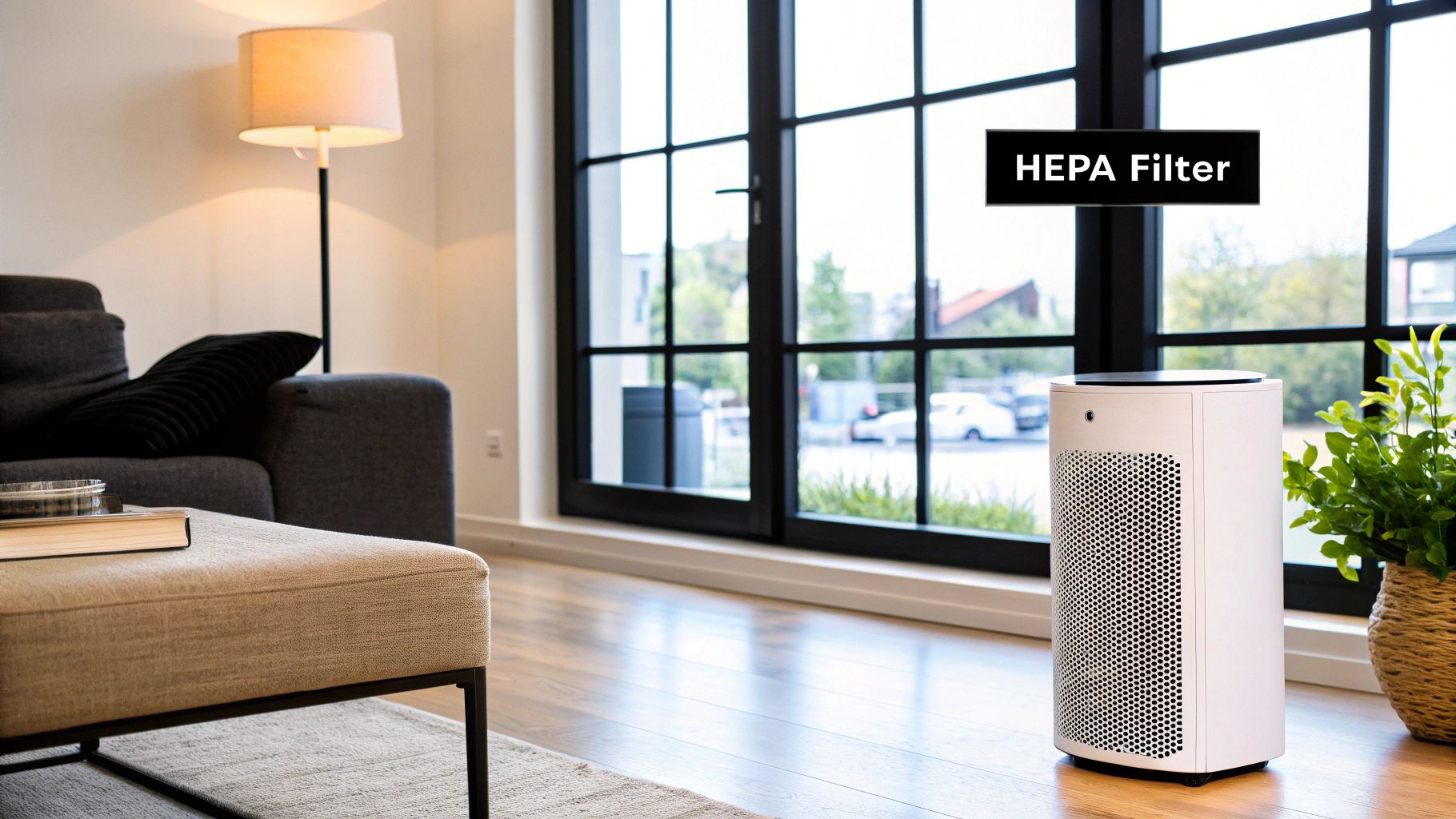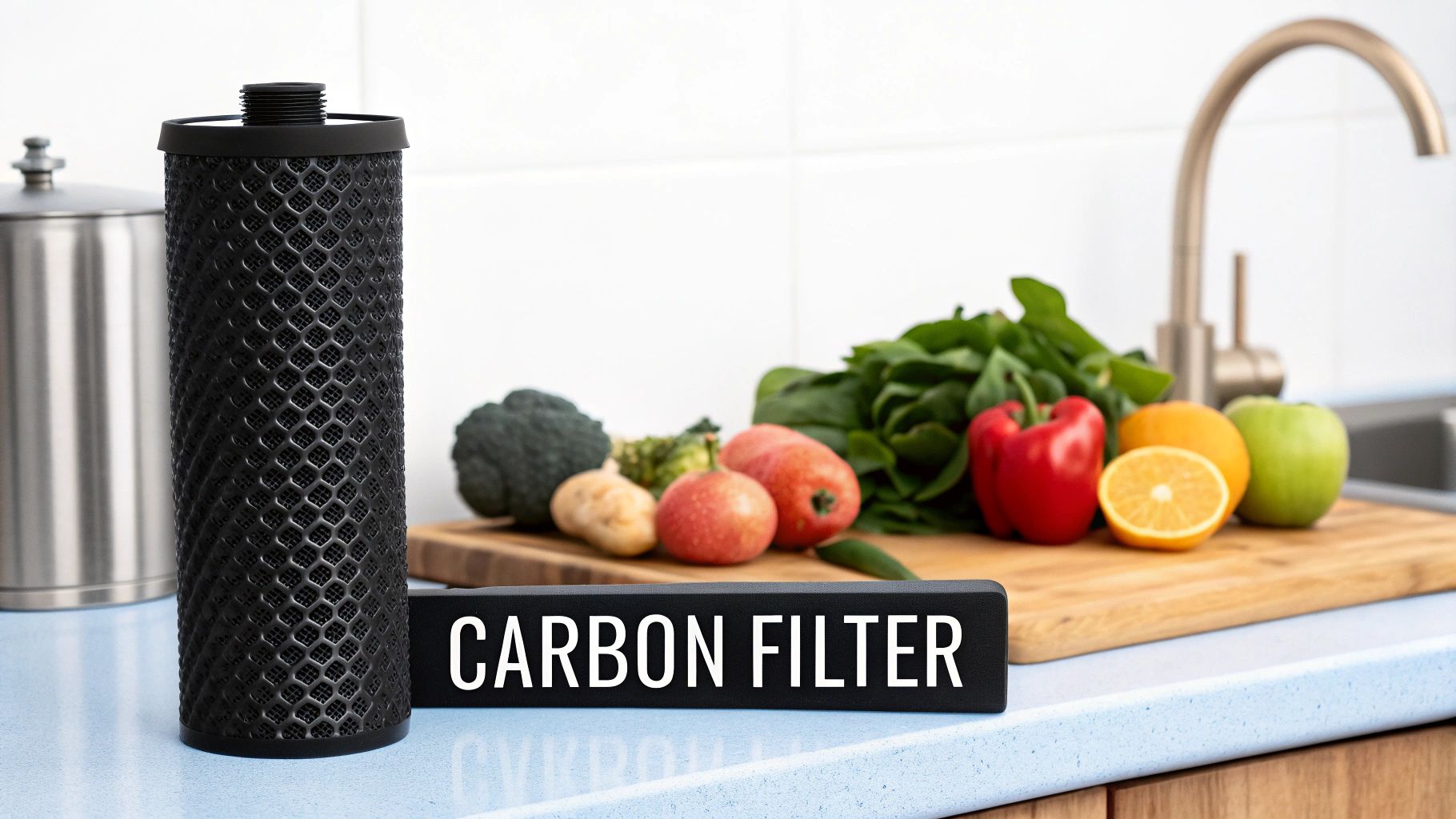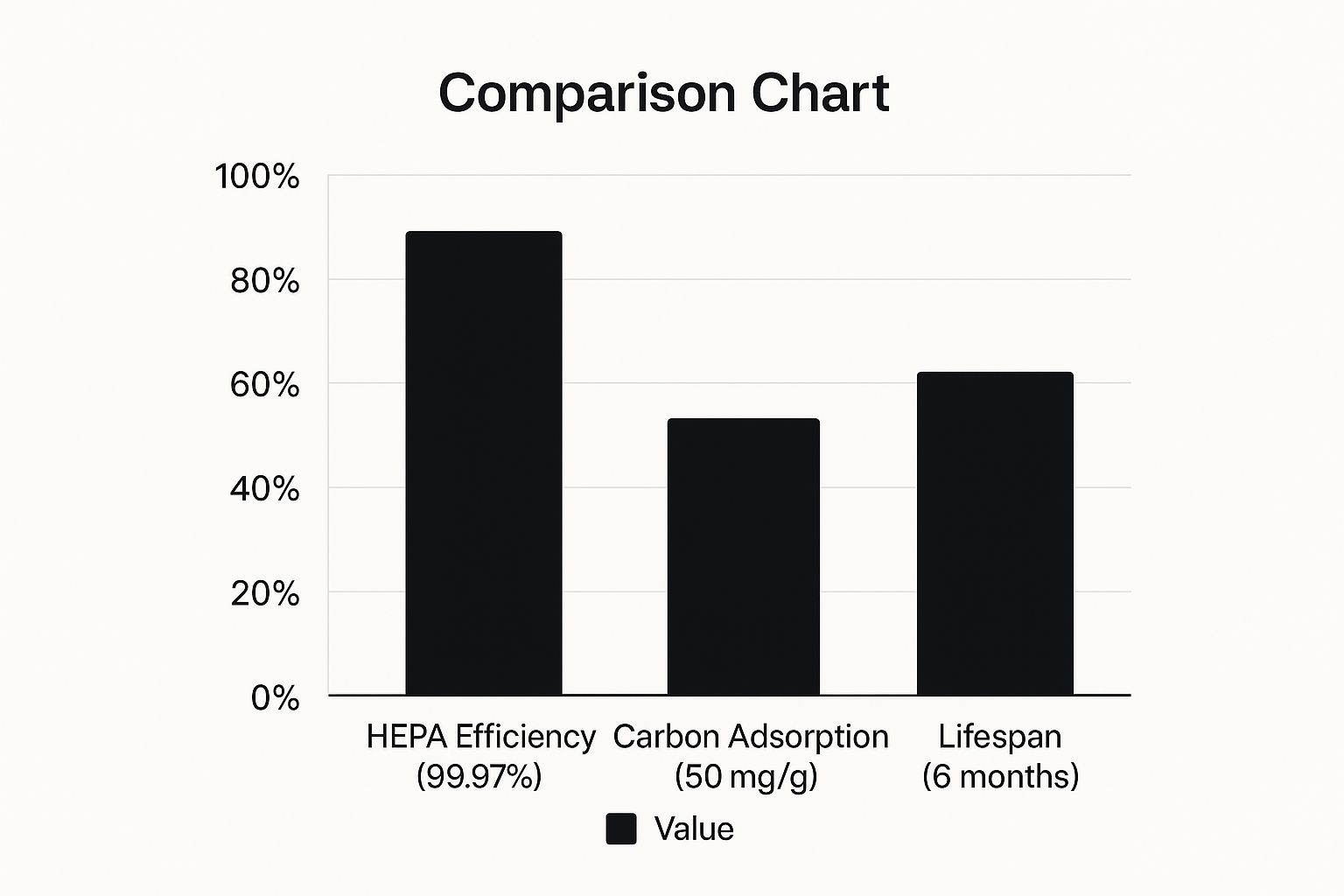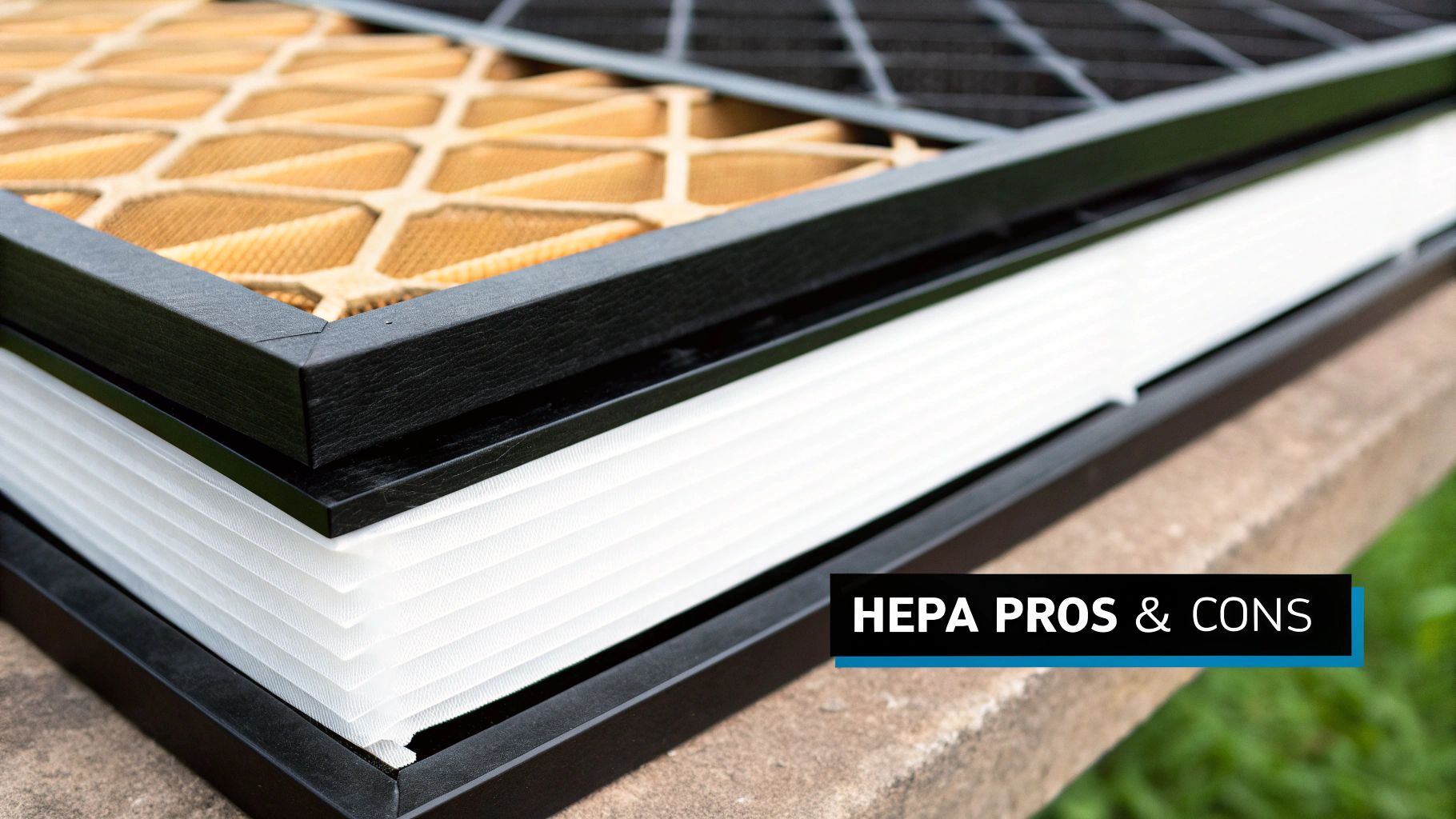HEPA vs Carbon Filter Which Is Right for You?
- shawncovenantaire
- Jul 14
- 12 min read
When you're trying to figure out the winner in a HEPA vs. carbon filter showdown, it’s important to realize they aren’t even in the same fight. They’re designed to solve completely different air quality problems. HEPA filters are physical traps for tiny particles like dust, pollen, and mold, while activated carbon filters act like chemical sponges, adsorbing odors, gases, and volatile organic compounds (VOCs).

So, neither one is better than the other across the board. They are simply specialized tools for different jobs.
HEPA vs Carbon Filters: An Immediate Comparison
Your choice between these two filtration workhorses comes down to one thing: what specific airborne troublemakers are you trying to get rid of? Think of a HEPA filter as a microscopic net that catches physical debris. An activated carbon filter, on the other hand, is more like a magnetic surface that pulls in and holds onto gases and smelly compounds. They aren't competitors; they are specialists in entirely different fields.
Getting this distinction right is absolutely critical if you want to create a genuinely healthy indoor space. If your main battle is against allergens that trigger asthma or those seasonal sniffles, a HEPA filter is your must-have. But if you’re more concerned with getting rid of last night's fish dinner smell, lingering pet odors, or that "new furniture" chemical scent, an activated carbon filter is what you need.
Quick Look: HEPA vs. Carbon Filter At a Glance
To make this even clearer, the table below gives you a high-level summary of what each filter does best. It's a quick way to see their core functions and ideal uses side-by-side.
Feature | HEPA Filter | Activated Carbon Filter |
|---|---|---|
Primary Target | Physical Particles (Dust, Pollen, Dander) | Gases, Odors, and VOCs |
Filtration Method | Mechanical Trapping (Interception, Impaction) | Chemical Adsorption (Porous Surface) |
Best For | Allergies, Asthma, Particulate Removal | Odor Control, Chemical Removal, Smoke |
Removes Viruses? | Yes, by trapping airborne droplets | No, it is ineffective against viruses |
Lifespan | Longer (Typically 12-24 months) | Shorter (Typically 3-6 months) |
This comparison should help you pinpoint which filter technology aligns with your specific air quality goals.
The most effective approach for total air purity often involves using both. Many modern, high-quality air purification systems integrate multi-stage filtration, combining a HEPA filter for particles with a carbon filter for gases.
The preference for powerful particle removal is clear in the market. Recent data shows the HEPA filter segment made up 53.6% of the U.S. air purifier market, which really highlights its role as the backbone of air cleaning technology. This is all thanks to its proven, reliable efficiency, a trend you can explore further at GrandViewResearch.com.
For a deeper look into solutions that bring these two powerful technologies together, check out our guide on comprehensive air purification systems.
How HEPA Filters Capture Airborne Particles

When you dig into the "HEPA vs. carbon filter" conversation, it's important to understand just what a HEPA filter is. It's not some high-tech electronic device or a chemical process. At its core, a HEPA (High-Efficiency Particulate Air) filter is a physical barrier, a thick mat of incredibly fine fiberglass fibers.
Think of it as a super-advanced net, but one designed to catch things you can't even see. It doesn't just block big particles; it cleverly uses three different physical principles to trap contaminants of all sizes with incredible success. This multi-layered attack is what makes it so effective.
The Three Mechanisms of HEPA Filtration
The filter's power comes from the completely random, tangled layout of its fibers. This design forces air to twist and turn through a chaotic maze. As airborne particles get pulled through, one of three things is bound to happen:
Impaction: Bigger, heavier particles like dust, pollen, and mold spores have too much momentum to follow the air's sharp turns. They just keep going in a straight line and slam directly into a fiber, getting stuck on impact.
Interception: Medium-sized particles are nimble enough to follow the airflow, but they still get snagged. As they flow past a fiber, they brush against the edge and stick to it, much like a boat getting caught on a low-hanging branch on a river.
Diffusion: This is where it gets really interesting. The tiniest particles, like some viruses and bacteria (typically under 0.1 microns), move in a frantic, zig-zag pattern. This erratic movement, known as Brownian motion, makes it almost certain they'll eventually collide with and stick to a fiber.
This triple-threat approach ensures that particles, from the largest to the smallest, are physically pulled out of your air.
The gold standard for a true HEPA filter is its proven ability to capture 99.97% of particles at 0.3 microns. This specific size is called the Most Penetrating Particle Size (MPPS) because it’s the most difficult for any filter to catch. If a filter can trap these, it can trap everything else.
This demanding benchmark is exactly why HEPA filters are essential in places where air purity is critical, like hospital operating rooms. They physically remove pollutants, offering a definitive fix for problems caused by airborne particles.
Of course, improving your home’s air can involve more than just filters. You can learn more about creating a healthier environment by exploring professional indoor air quality solutions. This purely mechanical process is what makes a HEPA filter fundamentally different from a carbon filter, which relies on a completely different, chemical-based principle.
How Carbon Filters Neutralize Odors and Gases

The "activated" part of the name is where the magic happens. The carbon, often sourced from coconut shells or wood, is super-heated in a low-oxygen chamber. This process etches the material with millions of microscopic pores, creating a massive surface area. In fact, a single gram of activated carbon can have a surface area that’s as big as a football field.
Adsorption vs. Absorption: The Critical Difference
It’s easy to get these two terms mixed up, but the distinction is crucial for understanding how these filters work. Absorption is when one substance gets drawn into another, like a sponge soaking up water. Adsorption, on the other hand, is purely a surface-level event where molecules stick to the outside of the material.
Think of it this way: a sponge absorbs water, becoming saturated through and through. Activated carbon is more like flypaper for odors; pollutants stick firmly to the surface of each tiny granule, held in place by molecular forces. This allows it to trap gaseous pollutants without turning into a soggy mess.
This unique property is what makes carbon filters the undisputed champions of chemical and odor removal. They are brilliant at capturing:
Volatile Organic Compounds (VOCs): These are the gases off-gassing from new paint, furniture, cleaning supplies, and even those plug-in air fresheners.
Household Odors: Lingering smells from last night’s fish dinner, the dog, or the garbage bin are effectively neutralized.
Smoke: Carbon filters are excellent at reducing the harmful chemicals and sharp smells from tobacco or wildfire smoke.
The primary job of an activated carbon filter is to act as a partner to a HEPA filter, not a replacement. One catches the particles, the other catches the gases and odors; a combination that provides the most complete air purification.
This complementary relationship is precisely why many high-end air purification systems use both. A HEPA filter might remove the visible soot from smoke, but only a carbon filter can deal with the invisible gaseous compounds and that persistent smell. This two-stage approach ensures both physical and chemical threats are removed from your indoor air, leaving it truly clean.
A Side-by-Side Look at Filtration Performance
Knowing how HEPA and carbon filters work is one thing, but seeing how they stack up in the real world is what really matters. When it comes to the hepa vs carbon filter debate, the best choice always comes down to which specific pollutants you're trying to get out of your air. It’s not about one being universally better; it's about picking the right tool for the job.
A HEPA filter is all about physically capturing tiny solid particles. Think of it as the bouncer for your home's air, stopping the physical stuff that makes you sneeze, cough, and feel miserable.
On the other hand, an activated carbon filter couldn't care less about those particles. Its job is completely different. It's designed to trap the gaseous and chemical pollutants that would sail right through a HEPA filter, making it your go-to for getting rid of smells and chemical vapors.
Performance Against Common Household Pollutants
Let’s get into the nitty-gritty of how each filter handles the most common airborne troublemakers. This direct comparison will help you see where each one shines and where it falls flat. Getting this right is the key to choosing a filter that actually cleans your air.
Allergens (Pollen, Dust Mites, Pet Dander) HEPA filters are the undisputed champions here. They are engineered to trap these microscopic irritants, bringing serious relief to anyone with allergies or asthma. A carbon filter does absolutely nothing against these types of allergens.
Mold Spores Just like allergens, mold spores are physical particles. A HEPA filter is incredibly effective at trapping them, which stops them from circulating and finding new surfaces to colonize. A carbon filter is powerless against mold spores.
Smoke Particles This is where things get a bit more complex. Smoke isn't just one thing; it's a mix of fine solid particles (like soot) and a nasty cocktail of smelly gases. A HEPA filter does a great job of snagging the visible soot and other fine particulates. But it’s the carbon filter that adsorbs the harsh, lingering odors and harmful gases. To truly tackle smoke, you need both.
The best air purification strategies always acknowledge that indoor air is a mix of both particles and gases. That’s why you’ll almost always find that high-quality systems use a multi-stage approach, combining the strengths of both HEPA and carbon filters to get the job done right.
The infographic below really drives this home, showing HEPA's incredible particle efficiency alongside carbon's impressive capacity for adsorbing chemicals.

This visual makes it clear: HEPA filters are masters of capturing physical particles with near-perfect efficiency, while carbon filters are all about their ability to adsorb chemical mass.
Filtration Effectiveness HEPA vs Carbon
To make your decision even easier, I've put together a table that breaks down how each filter performs against the most common indoor pollutants. Think of this as your cheat sheet for choosing the right solution.
Contaminant Type | HEPA Filter Effectiveness | Carbon Filter Effectiveness | Best Solution |
|---|---|---|---|
Allergens & Dander | Excellent (Traps 99.97% of particles) | None | HEPA Filter |
Mold Spores | Excellent (Physically captures spores) | None | HEPA Filter |
Household Odors | None | Excellent (Adsorbs odor molecules) | Carbon Filter |
VOCs & Chemicals | None | Excellent (Adsorbs gaseous pollutants) | Carbon Filter |
Smoke | Good (Removes fine particles/soot) | Good (Removes odors/gases) | Combination |
Ultimately, looking at this breakdown shows there’s no single winner. The best filter depends entirely on what’s floating around in your air.
When to Choose HEPA, Carbon, or Both

When it comes to the HEPA vs. carbon filter debate, the right choice really boils down to a quick audit of your living space and the specific air quality issues you're facing. Each filter is a specialist, designed to tackle different problems. The goal is to match the filter's strengths to your unique needs, so you get the clean air you're actually after.
First, think about what's driving your need for cleaner air. Are you constantly fighting seasonal pollen? Is pet dander from your furry friend making everyone sneeze? In these situations, your main enemy is physical particles. That makes a HEPA filter your non-negotiable first choice. It’s the gold standard for trapping allergens, dust, and other tiny particulates.
Scenarios for Carbon and Hybrid Systems
Now, let's picture a different environment. Maybe you're in a downtown apartment where you can smell the traffic fumes, or you've just finished a renovation and the lingering paint smell is giving you a headache. These problems are caused by gases and volatile organic compounds (VOCs); pollutants that a HEPA filter simply can't touch. This is where an activated carbon filter is essential, as it's designed specifically to adsorb these odors and chemical pollutants.
But what if you're dealing with a bit of both? This is the reality for most of us. You might have a dog that sheds dander (particles) and creates odors (gases). Or perhaps you live in a place with high pollen counts that also gets hit with wildfire smoke from time to time.
The most robust solution for comprehensive air purification is a hybrid system. By combining a HEPA filter for particles with an activated carbon filter for gases and odors, you create a multi-stage defense that tackles nearly every common indoor air pollutant.
This dual-filter strategy is quickly becoming the standard for good reason; it’s built to handle the complex mix of contaminants we find in our homes today.
Making a Long-Term Investment
This growing need for versatile solutions is reflected in the global demand for effective air cleaning. The entire air filtration market, which includes both HEPA and carbon technologies, is projected to jump from USD 16.63 billion to over USD 30.83 billion by 2032. This surge is fueled by greater consumer awareness and the move toward smart purifiers that integrate both filter types.
Opting for a hybrid system is really an investment in your total air quality. While the initial cost might be a bit higher, it takes the guesswork out of the equation and delivers real peace of mind. Just remember, both types of filters need to be replaced regularly to keep working effectively. To get a better handle on your maintenance schedule, it's helpful to understand how often you should change your A/C air filter in Arizona. After all, a properly maintained system is a system that works.
Filter Lifespan, Maintenance, and Cost
Great air purification isn't a "set it and forget it" deal; it’s an ongoing commitment. When you put a HEPA filter up against a carbon filter, you'll find that their lifespans and long-term costs are worlds apart. These two technologies wear out in completely different ways, which means they demand unique maintenance schedules.
Think of an activated carbon filter as a high-tech sponge for gases and odors. Once its millions of tiny pores are saturated, it just can't absorb anymore. In homes with strong smells or high levels of VOCs, this happens pretty fast. As a result, most carbon filters need to be replaced every 3-6 months. The telltale sign? The very smells you were trying to get rid of start creeping back in.
Comparing Long-Term Upkeep
On the flip side, a HEPA filter has a much longer working life. Because it physically traps particles, it only stops working when it gets so clogged that air can't push through effectively anymore. This process is much slower.
HEPA Filter Lifespan: You can typically expect a HEPA filter to last anywhere from 12 to 24 months. The lifespan really depends on the amount of dust and particulate pollution in your home. Your main cue for a replacement is a noticeable drop in airflow from your purifier or HVAC vents.
Carbon Filter Lifespan: These are the sprinters, not the marathon runners, usually lasting only 3-6 months. Their lifespan is all about adsorption capacity, not airflow.
The crucial takeaway is this: while a HEPA filter might cost more upfront, the frequent replacement of a carbon filter can lead to higher costs over time. You have to factor this recurring expense into your budget to keep your air quality high.
Keeping up with these maintenance cycles is a huge part of making sure your system runs as it should. For a more complete look at system upkeep, you can find some great advice in our essential guide on how to maintain your HVAC system. Ultimately, finding the right balance between cost and replacement frequency is what will help you make a smart, sustainable choice for your home's air.
Frequently Asked Questions
Even with a detailed comparison of HEPA and carbon filters, some practical questions always come up. Let's tackle some of the most common ones to help you apply this knowledge to your own home and feel confident about your choice.
Can I Use a Carbon Filter Without a HEPA Filter?
You certainly can, but it’s not the best strategy if you're aiming for truly clean air. A standalone carbon filter is fantastic at its specific job; absorbing odors, gases, and volatile organic compounds (VOCs). However, it does absolutely nothing to capture the physical particles that are the main culprits for most allergies, like dust, pollen, pet dander, or mold spores.
For genuinely purified air, especially in homes where allergies or asthma are a concern, using both together is far superior. Pairing the two ensures you’re hitting pollutants from all angles, tackling both airborne particles and gaseous contaminants.
Do HEPA and Carbon Filters Remove Viruses?
This is a really important distinction. HEPA filters are highly effective at capturing the tiny aerosol droplets that viruses travel on, physically trapping them and pulling them out of the air. They catch the particles but don't actually kill or neutralize them on their own.
On the other hand, activated carbon filters are not designed to capture biological particles like viruses. For reducing the concentration of airborne viral particles, a HEPA filter is the right tool for the job. Of course, it should always be part of a larger strategy that includes good ventilation and hygiene practices.
How Do I Know if My Air Purifier Uses Both Filter Types?
The easiest way is to check the product specifications directly from the manufacturer. Reputable air purifier brands will be upfront about their filtration technology, often promoting a "multi-stage" or "hybrid" system that clearly lists both "True HEPA" and "Activated Carbon" as separate layers.
Your user manual is another great resource. It will break down the specific details of each filter inside the unit, explaining its purpose and, just as importantly, its recommended replacement schedule. This ensures you can maintain each part correctly to keep the whole system running at its best.
At Covenant Aire Solutions, we know that every home's air quality needs are different. Our certified technicians can help you find the perfect filtration solution, whether it's an advanced standalone unit or an integrated whole-home system. Ensure your family breathes the cleanest air possible by visiting Covenant Aire Solutions today.
